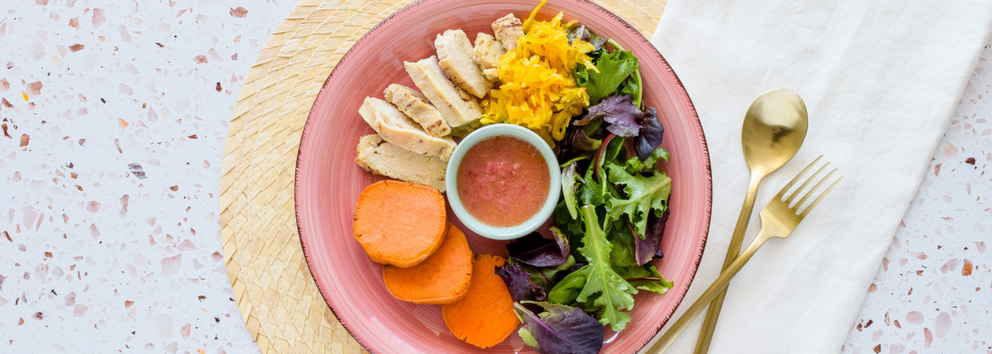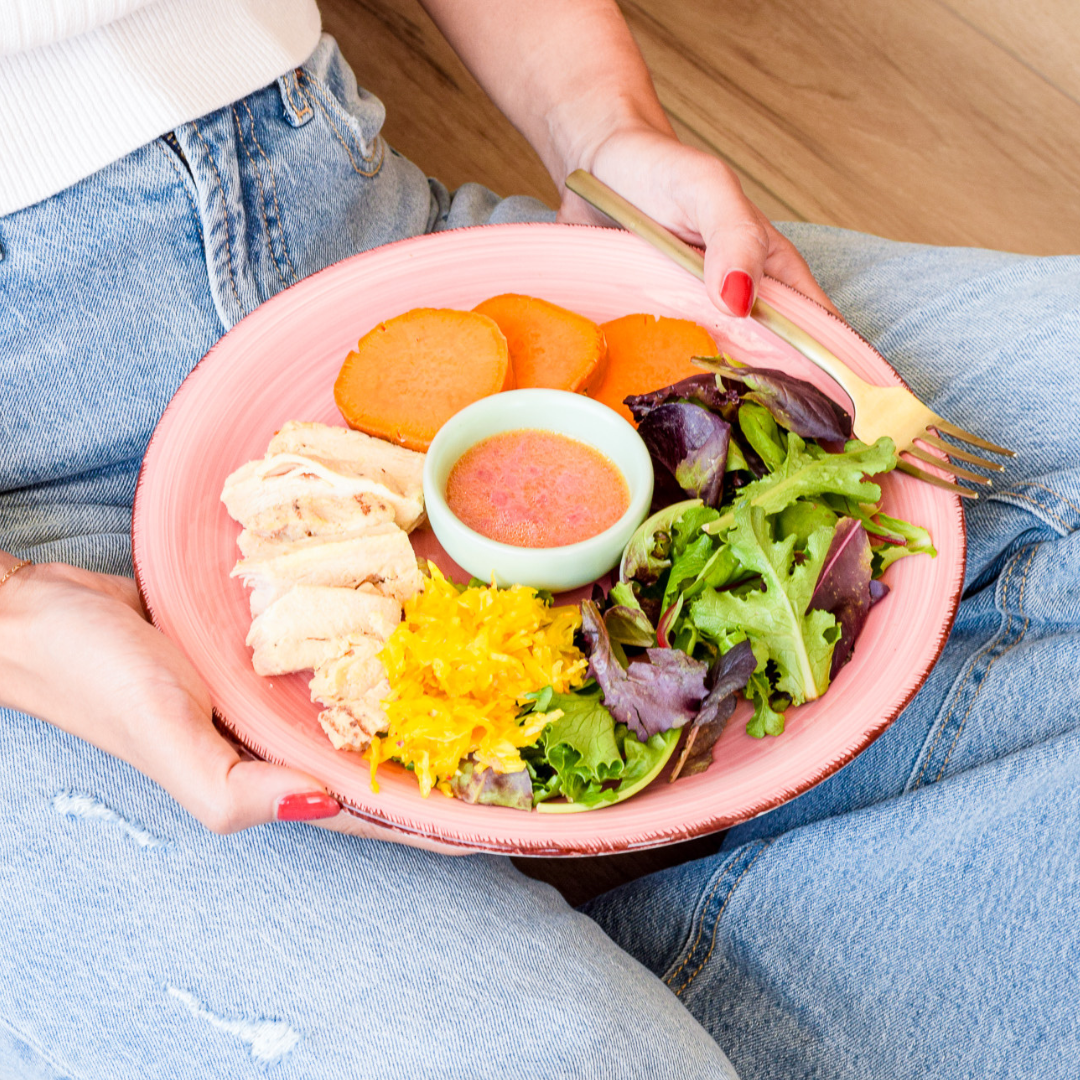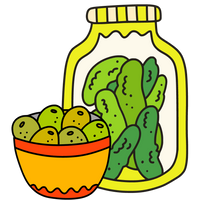
You’ve probably heard the buzz about a "gut-healthy diet," right? It’s not just a trend— a gut-healthy diet is kind of a big deal for feeling awesome and keeping things running smoothly inside. So, grab a fermented pickle (we’ll tell you why in a bit), and let’s dive into how easy it is to prepare a healthy plate full of gut-friendly foods using our gut-healthy diet guide below.
In this article, we’ll cover the fundamentals for a gut-healthy diet, including macronutrients, portion size, healthy plate guidelines, and why you need fermented foods to maximize digestion and nutrient absorption with easy recipes to incorporate them into your diet.
Related: Creative Ways to Eat Fermented Foods

The Key to a Gut Healthy Diet: Macronutrients in Balance
When we talk about a gut-healthy diet, we're really talking about balance. Part of that is balancing macronutrients, which are the three nutrients your body needs in large quantities to run smoothly. Also known as macros, they consist of protein, fat and carbohydrates. SSome spend a lot of time and energy counting healthy diet macros to hit very specific goal numbers, but for most people it doesn’t need to be that complex.
Others may have fears around consuming too much of a certain macronutrient. There have been many big-name diets trending over the years that villainize fat and others that emphasize that carbs are “bad.” So, what’s the secret to a gut healthy diet? Go back to the basics and create a healthy plate with as many real, nutrient-dense, whole foods from each macro category.
Next, we’ll break down the importance of each macronutrient, and provide a few examples along with general portion sizes.

Protein
These are essential for just about everything your body does, but especially for the repair and growth of tissues, including those in the digestive track. This could look like some sustainably sourced chicken or salmon, or even legumes for a plant-based option.
A typical serving of protein is 4 to 6 oz. For animal-based protein that looks like the size and thickness of the palm of your hand.
The amount of protein needed each day varies, and depends on many factors such as weight, activity-level, and state of health. As a baseline for a gut healthy diet, 0.8g of protein should be consumed per kg of body weight:

Remember, the 0.8 factor is just a baseline. An athlete or someone in a state of physical recovery for example, may need 1.7 g of protein per kg of ideal body weight.
Fat
We’re talking the heart-healthy kind here! Healthy fats are crucial for nutrient absorption and keeping the gut lining strong and healthy. They provide long-lasting energy and support cell health. Sources like avocados, olive oil, and seeds provide the right kind of fats that promote a happy gut environment.
The fats you want to avoid are ones that are refined and processed, like the fats in packaged foods, deep fried foods, or canola oil. These fats are oxidized which can damage cells and cause inflammation in the body.
A little goes a long way with healthy fats, because 1 gram of fat has 9 calories whereas 1 gram of protein and carbs has 4 calories. A standard serving size would be 1 tablespoon of fat/oil or 2 tablespoons of nuts/seeds.

Carbohydrates
Carbs have gotten a bad rap, but whole grains, fruits and veggies are the types your gut loves. They fuel your body and feed the friendly bacteria in your gut, which are the building blocks for a gut healthy diet.
There’s a lot of misinformation out there when it comes to carbs. Some diets promote a very low carbohydrate intake, and it's even trending to try a “zero carb” diet strategy. But that’s not really an accurate term because it’s almost impossible to truly consume zero carbs. Fruits and vegetables are carbohydrates that the body needs to function!
Just like with fats, quality is key with choosing your carbs. Processed and refined carbs (think packaged foods, and breads made with white flour) have been stripped of any nutritional value and cause spikes in blood sugar.
Complex carbs like fruits, vegetables and whole grains are filled with micronutrients, fiber, and have a slower glucose release compared to refined carbs, resulting in more balanced blood sugar.
So how many carbs should you eat? It’s better to focus on the daily grams of fiber, which go hand in hand with carbs. A good starting point is to aim for 20 – 40 g of fiber per day, with 35 – 50 being optimal.
You’ll find fiber in all the delicious complex-carb foods like leafy greens, starchy veggies, fruits, legumes, and whole grains. To get an idea for serving size, it’s ½ cup for most vegetables, fruits and grains which is what would fit in the palm of a cupped hand. For leafy greens the serving size is 1 cup, and your visual cue is a fist.
If this all feels a little too complex (pun intended), don’t worry! We’re about to show you what this looks like for any given meal.
Crafting a Healthy Plate: A Visual Guide
Creating a gut healthy plate is as easy as pie (well, maybe healthier than pie)! Picture this: half of your plate filled with colorful, diverse vegetables, a quarter with quality proteins, and the remaining quarter with whole grains or starchy veggies. This not only ensures a nutrient-dense meal but also supports the diversity of the gut microbiome, a key aspect of a gut-healthy diet.
Let’s not forget our fats! A tablespoon or two of oil, nuts or seeds are a great way to add flavor and nutrition to each meal.

Elevating with Micronutrients: The Olive My Pickle Touch
While macronutrients form the structure of our plate, micronutrients, probiotics, and digestive enzymes play an important role in making a healthy plate. Fermented foods are the superstars of a gut-healthy diet, offering a delicious and natural source of probiotics.
That's where we come in! Not to brag, but our extra-large selection of fermented products like sauerkraut, kimchi, and pickles aren’t just condiments; they’re nutritional powerhouses.
Brimming with probiotics, these ferments support gut health and digestion, enhance nutrient absorption and add a tangy zest to every meal. Imagine a forkful of crisp salad, elevated with the crunch and flavor of fermented veggies — delicious!

Incorporating Ferments: The OMP Way
To truly benefit from a gut-healthy diet, it must become part of your lifestyle and daily routine, not just a fad or phase. Whether it's adding a scoop of sauerkraut to your salad or enjoying a pickle as a snack, these small habits contribute significantly to gut health and overall vitality.
Here’s our top tips to keep in mind when incorporating ferments:
- 3X a day: Eating (or drinking!) ferments three times a day is our recommendation. This constant introduction of beneficial bacteria aids digestion and supports gut health.
- Start slow: Gradually introducing fermented foods and listening to your body allows your digestive system to adjust without discomfort. Read more about our recommendations on getting started with ferments here
- Mix it up: Incorporating an abundant variety of ferments ensures a diverse microbiome and keeps your taste buds from getting bored. We’ve got you covered with over 40 ferments to choose from!
- Enzyme advantage: Consuming fermented foods with every meal introduces enzymes that assist in breaking down nutrients for better absorption.
- The gut health trifecta: Combine fats, fiber, and ferments to enhance nutrient absorption and support gut health. Healthy fats increase the bioavailability of micronutrients, while soluble fiber, or prebiotics, feed the good bacteria in your gut.
Gut Health Villains
We know you already know this, but we’re that friend that’s going to say it anyways (with lots of love, of course!). There’s some food and drinks that are going to work against you on your journey to a gut-healthy diet. If you are able, we recommend removing or limiting the following:
- Reduce intake of sugar and processed foods, which disrupt gut balance
- Be mindful of gluten and alcohol, which irritate the digestive system
- Cooked foods lose nutrients and enzymes in the heating process. Pair them with fermented or raw foods to maintain an enzyme-rich diet
For a deeper dive into gut health villains check out our article on How to Improve Gut Health
Quick Meals and Snacks for a Healthy Plate
Who said eating for gut health has to be time-consuming? Here are some quick meal ideas that pack a nutritious punch:
- Sardine Salad: Toss sardines with your favorite greens, add chopped fermented pickles for a probiotic boost, and serve with seed crackers for a crunchy finish.
- Turkey Roll-Ups: Wrap sauerkraut in a slice of turkey for a protein-rich, gut-friendly snack.
- Sauerkraut with Olive Oil: A drizzle of olive oil on sauerkraut combines healthy fats with probiotics for a simple, satisfying snack.
- Avocado Stuffed with Sauerkraut: The creamy texture of avocado pairs wonderfully with the tang of kraut.
- Peanut Butter and Pickles: An unexpectedly delightful combo that balances creamy with crunchy.
We have a lot more recipes and meal ideas on the blog, check out this roundup of a few of our favorites:
- Olive Recipes for Mediterranean Diet
- Top 20 Healthy Road Trip Snacks
- 4 Gut Friendly Protein Salad Recipes
- 5 Quick Lunch Ideas for a Healthy Gut
- Gut Healthy Taco Night
- Summer Olive Recipes
Cultivating Balance: A Gut-Healthy Farewell
In conclusion, embracing a gut-healthy diet isn't just about following trends; it's about creating a healthy relationship with your food that nurtures your body from the inside out.
By focusing on a balanced mix of macronutrients, incorporating a variety of whole foods, and making fermented foods a staple in your daily meals, you're laying down the foundation for optimal gut health. It's the simple choices and small changes that can make a big difference in how you feel.
So, as you journey towards a more gut-friendly lifestyle, remember that every meal is an opportunity to support your well-being. Here's to a healthy plate and a vibrant life, filled with the flavors and nutrients your body loves.









